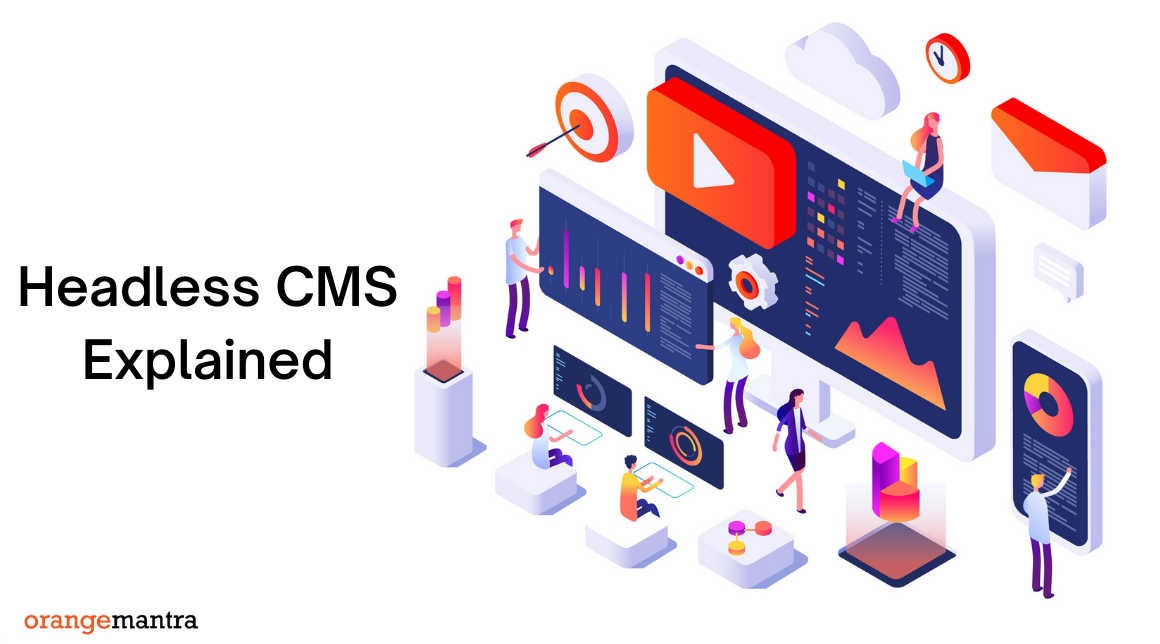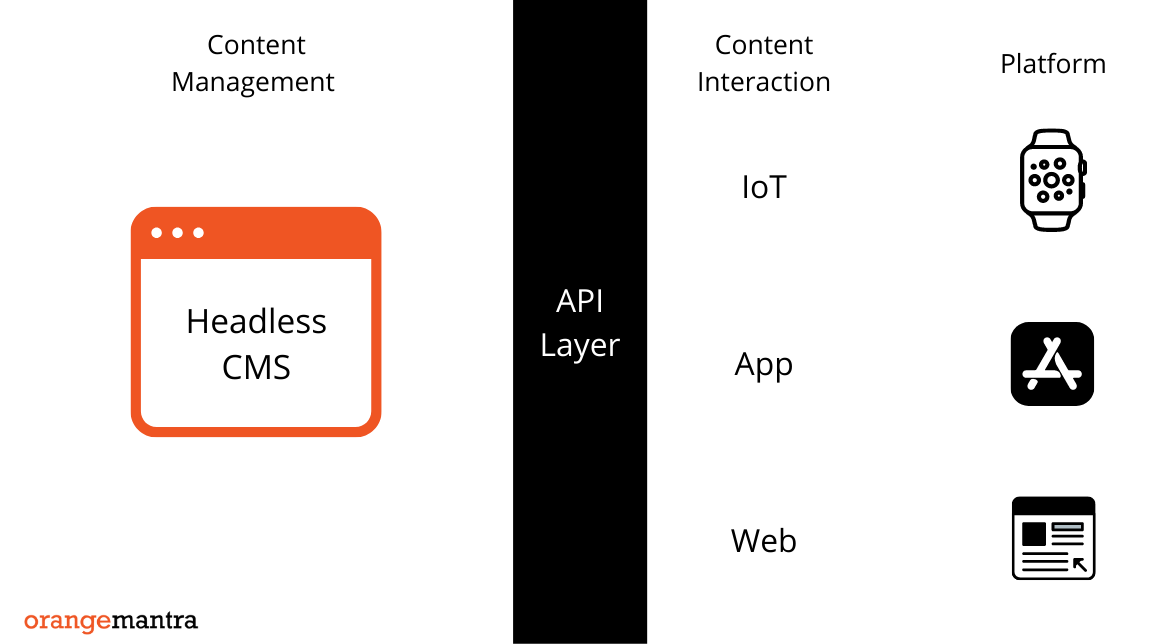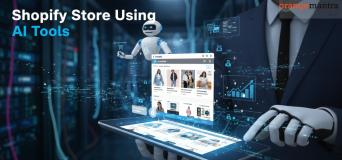
Here’s what you will learn:
Are you thinking of advancing your digital business? Is creating an enterprise website, mobile app, digital displays, conversational interface, and mobile sites part of your plan? If yes, then you will be needing a technically integrated content management system to manage the content of your omnichannel platforms. No, you cannot manage it all, with a traditional CMS (WordPress, Joomla, Drupal, etc.). To deliver an omnichannel user experience to customers, you need Headless CMS assistance.
To explain it further, we have this guide fully dedicated to understanding the meaning, relevance, benefits, and use cases of Headless CMS. Stay with us to know why more and more enterprises are embracing headless content management systems.
Table of Contents
Need to Have Headless CMS in Place
To understand what a headless CMS is all about, let us first understand the relevance of traditional CMS.
Some of the prominent CMS platforms like WordPress, Joomla, Drupal, and many more have been around for several years. Each of the CMS does the commendable work of managing the overall content of the website and present distinctive content elements like images, text, videos, graphics, and more.
This is what we refer to as traditional CMS doing the same task for years for a single best platform. Now, fast-forwarding it to the current business environment, where you cannot just rely on a website to drive traffic and increase conversions.
As the digital platforms evolved, the need for flexible and scalable enterprise solutions like mobile apps, digital displays, and mobile sites increases. To manage it all simultaneously, you need to have technically advanced Headless CMS.
What is a Headless CMS?
Let’s come to the point of understanding headless content management systems.
A headless CMS is a type of back-end content management system which is decoupled from the presentation layer of the platform i.e. frontend. Simply to say, this CMS does have a front-end layer and only the back-end is there. It allows enterprises to create any form of structured content and for any enterprise platform. This further means, you can create any content that can be published anywhere on the app, website, and more.
By getting rid of the front-end layer, the CMS becomes a content only data-source in which your job is to create, publish, and manage content as per the personalized experience of customers.
Difference Between Traditional CMS & Headless CMS
To get a better hang of headless CMS, it is important to know the difference between the traditional CMS.
Traditional Content Management System
- It is driven by, “What you See is What you Get”, phenomenon.
- You install the CMS to access its innumerable features.
- Both front-end and back-end are coupled.
- It packs all the functionalities to create, edit, publish and manage content.
- It is limited to the extent of managing a single website only and showcase the published content.
Headless Content Management System
- Backend is only used for managing content.
- Frontend is disconnected and disabled.
- Content is published sent via API.
- One distributed system to manage the content of the website, mobile app, mobile site, etc.
Real-Life Examples of Headless Content Management System
Adoption of new and revolutionary technology is incomplete without looking at its impact on the marketplace. And, this can be viewed by looking at the popular brands using headless CMS for their enterprise to make a huge difference.
Amazon: The largest online retail brand offers a personalized shopping experience to customers by integrating the virtues of headless CMS. The brand enables different ways to meet the shopping requirements of customers. Just like, it uses Echo to enable voice commands along with Dash, which handles user’s specific devices to feature a particular set of products.
Toyota: The automobile giant has recently switched to headless CMS along with APIs. It facilitates the integration of headless CMS with legacy and IoT to deliver an outstanding level B2B and B2C experience.
Tesla Motors: The company is rapidly recruiting the sources to manage the facets of their headless CMS commerce solutions.
Sony: The largest electronics manufacturer and retailer has already combined the features of CMS with another eCommerce marketplace. The company aims to deliver an exceptional electronics shopping experience under the umbrella of B2B, B2C, and IoT-driven commerce marketplace.
Nike: To deliver an omnipresent shopping experience to customers, Nike has adopted Headless CMS to offer a mobile-first approach.
Why Enterprises are Embracing Decoupled CMS?
You must be thinking as to why Headless CMS has such a valuable proposition for such enterprise giants in the marketplace. Well, it is the future proof of your company’s digital presence to adopt multiple selling channels and manage content effectively within less time and effort. More importantly, it will be beneficial for enterprise managers and developers to create an interactive experience for customers with less investment and to give the business a competitive edge.
Following are few more reasons to adopt decoupled CMS for your enterprise.
Provide Content-Driven Experience on Different Channels: Most enterprises using the traditional content management system are under the limitation of not supporting additional touchpoints like mobile app, web app, tablets, digital signs, wearable devices, social channels, and more. Traditional CMS restricts the movement to a single website only. On the other side, headless CMS is capable of providing customized content to all the marketing channels without having the restrictions posed by the front-end.
Faster Update of the UI: With the monolithic CMS, it takes time to change the UI as per personalized user experience. With headless CMS, UI can be changed quickly to provide an enhanced level of user experience.
Overcome Technical Limitations: Front-end apps have UX technical limits. While headless CMS has no such limit. Thus, it will be no chance of negative consequences or higher cost within the enterprise.
Key Benefits of Headless CMS
1. Omnichannel Commerce Management
If creating omnichannel products/services experience the aim of your business, then you will be needing headless CMS. Without this, you have to create content for each marketing touchpoint, invest in multiple CMS’s for separate platforms, and devote much time and effort.
A headless CMS eliminate the problem managing multiple content management system. It is a single-best solution to act as your centralized place to update content on all platforms at once. Marketers can create different forms of content and developers access the same using APIs to update on distinctive platforms.
2. More Flexibility to Developers
APIs can store any form of content related to your business. It losses the burden of developers and make it easier to access the content from different APIs. Not only this, developers can choose their choice of programming language and be flexible to move from one framework to another. With headless CMS, you can easily change or switch between technologies accordingly.
3. Scalability
In case, backend system requires maintenance, then it will be easier for developers to manage the load and bring necessary changes under a headless framework. Choosing a decoupled CMS separates the front-end and the back-end. It offers the flexibility to add unlimited options or functionalities to the back-end without having any effect on the front-end.
Do you Really Need Headless CMS for your Enterprise?
The digital ecosystem of business is changing rapidly. Today, you cannot rely on the single-best web solution to reach a targeted audience, enhance sales, and ROI. You need to market your product/services through different digital channels. And, to manage the content of different platforms, you need the support of headless CMS. Because, with traditional CMS, you cannot bring flexibility and scalability to content management.
Avail headless CMS management services from a pioneer digital transformation and business acceleration solutions provider company, OrangeMantra. Know more about headless CMS and headless commerce to bring a new direction to your business and open different channels of offering products and services.
Frequently Asked Questions
1. Why Headless CMS is Important for Businesses?
For the advancement of online business and to reach a wide spectrum of audiences via different channels, it should be needed. Traditional CMS has a certain limitation to manage the content of a single web platform. Whereas, decoupled headless content management system can connect multiple marketing channels to publish content in less time and effort.
2. How Much Investment is Required in Headless content management system?
Investment into headless content management system depends on the scale, objectives, reach, and complexity of your online business. At first, the strategy is created, goals are set, the target audience is finalized, and budgeting is done to decide the final cost of headless content management system development.
3. In How Much Time Period Headless CMS be Ready?
The time duration to develop a headless CMS for your enterprise depends on your requirements, scalability, resources, and budget. Every single business has different requirements and objectives to fulfil. So, the time period to develop Headless content management system also differs for diverse enterprises.



